Dim Sum Delights: A Guide to Chinese Dim Sum
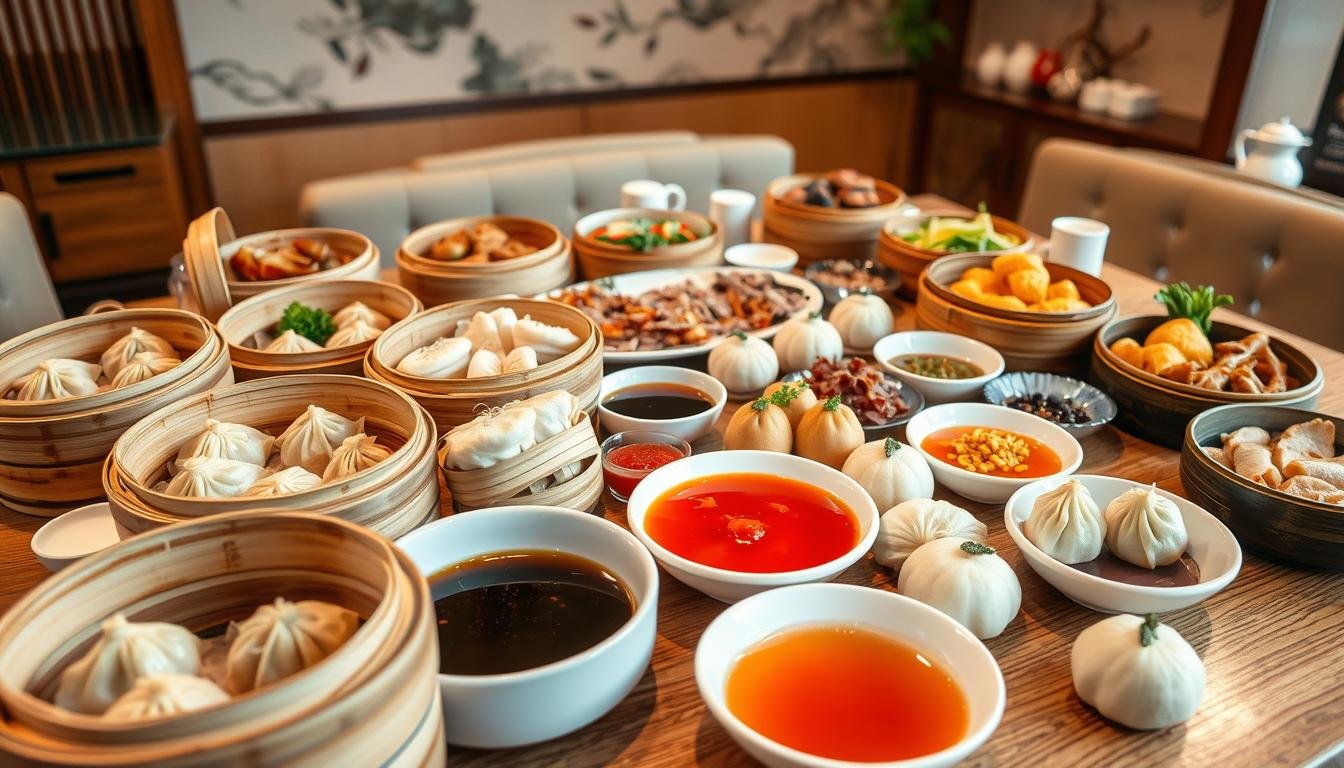
Imagine a Sunday brunch so popular it’s a frenzy. Dim sum draws people with its charm. Whether new or a fan of Chinese food, dim sum is captivating. This guide explores dim sum’s history, showing it’s more than food. It’s a cultural expression loved by many.
In places from Hong Kong to Richmond, BC, dim sum is a treasured ritual. This journey into dim sum shows its variety and the best spots to enjoy it. You’ll find recipes that’ll make your mouth water.
This guide helps you make dim sum at home. It has 24 recipes with photos and pronunciations. You’ll learn about dim sum’s history. And get tips to host your own dim sum brunch. Enjoy making dishes like Siu Mai and Cheung Fun.
Dim sum is more than food; it’s an experience. Are you ready to explore like the 132 users who love this guide? Plus, 114 people have shared their stories. Join them and discover the joy of dim sum.
Exploring the Origins of Dim Sum
Dim sum comes from Asian food traditions, starting in China’s teahouses on the Silk Road. The words “Dim Sum” mean “touch the heart” in Cantonese. They show how this food aims to please with tasty, small dishes.
The Cultural Significance of Dim Sum
“Yum cha,” or “drink tea,” ties to dim sum’s cultural importance in Cantonese regions. It began in Guangdong and Hong Kong. Here, travelers rested and enjoyed tea with various small plates.
Today, sharing dim sum in a lively teahouse is a cherished social experience. It brings family and friends together over meals.
Traditional Teahouses and Dim Sum
At traditional teahouses, the menu highlights dumplings, buns, and rolls. These often have pork, shrimp, or veggie fillings. The meals happen at brunch or lunch, focusing on Cantonese cuisine’s fresh, shared dishes.
Some places have carts that offer over 100 choices on busy days. This makes choosing fun and easy.
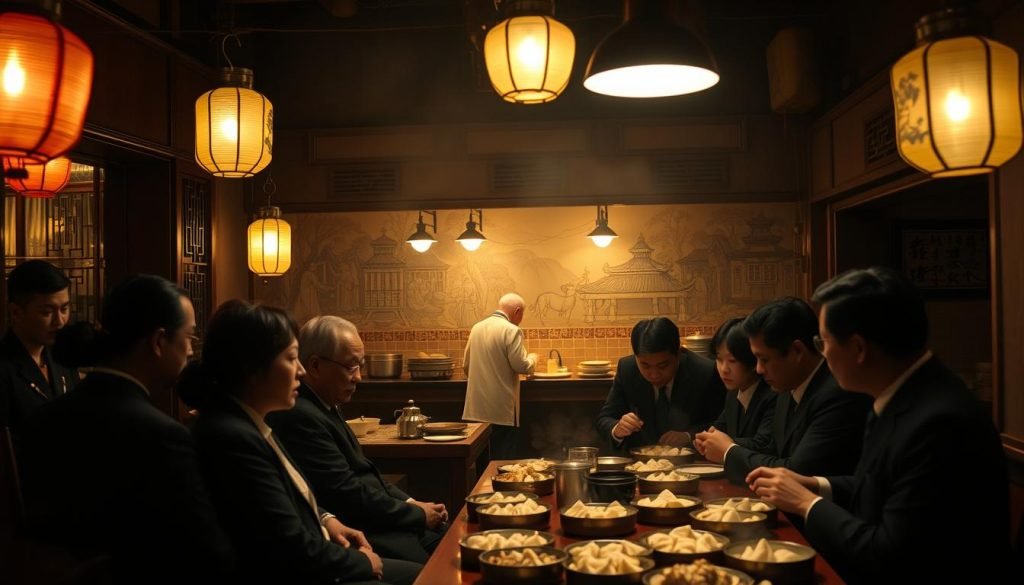
Regional Variations Across China
Dim sum shows different tastes across China while keeping its key spirit. Despite common ground, regions vary in ingredients and how they cook. For example, Har Gow and Siu Mai can taste a bit different depending on where you are.
In Cantonese cuisine, fresh veggies and seafood stand out. It often uses mild spices to bring out the natural flavors.
Popular Dim Sum Dishes You Must Try
Dim sum is a fun food adventure. It’s filled with different dishes that taste and feel unique. These dishes are key to any dim sum meal.
Har Gao: The Classic Shrimp Dumpling
Har Gao dumplings show if a dim sum place is good. They have see-through dough with tasty shrimp inside. These dumplings are a top pick for many.
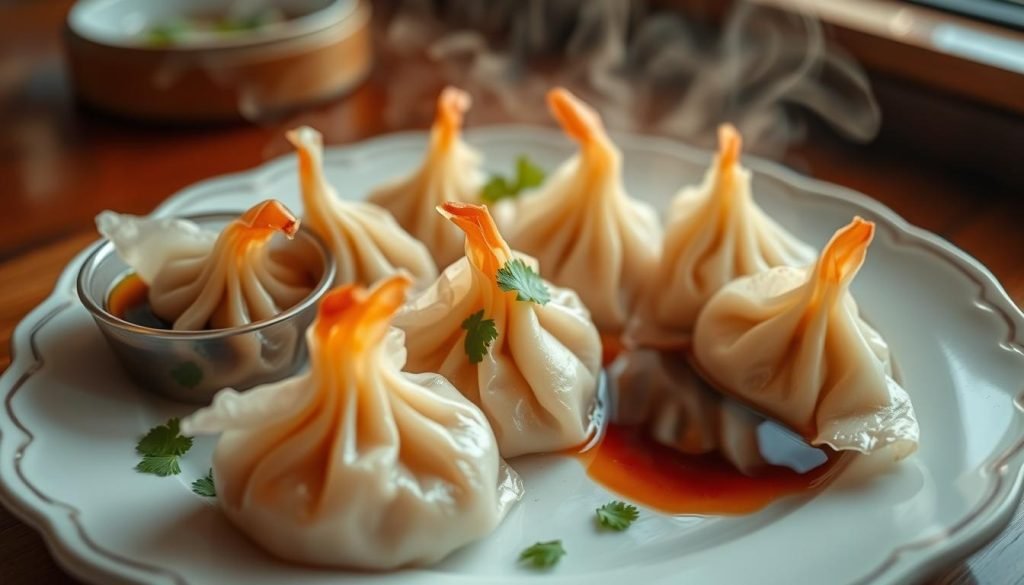
Siu Mai: Pork and Mushroom Dumplings
Siu Mai mixes pork, shrimp, and sometimes mushrooms. They don’t hide the filling like other dumplings. This makes them a must-have at dim sum spots.
Cheung Fun: Savory Rice Noodle Rolls
Cheung Fun rolls are made from smooth rice noodles. You can choose different stuffings like shrimp or BBQ pork. It shows the fun variety of dim sum.
| Dish | Main Ingredients | Estimated Cost |
|---|---|---|
| Har Gao | Shrimp, Rice Flour | $4 per steamer basket |
| Siu Mai | Pork, Shrimp, Mushrooms | $4 per steamer basket |
| Cheung Fun | Rice Noodles, Shrimp, BBQ Pork, Beef | $3 per roll |
| Egg Tarts | Egg Custard, Pastry Dough | $2 per piece |
Egg Tarts: A Sweet Ending
Egg Tarts make a sweet end to your meal. They have a soft filling and flaky outside. These treats are favorites in Guanzhong and Hong Kong.
Essential Ingredients for Dim Sum Recipes
Making authentic dim sum at home is very rewarding. It’s important to know about key dim sum ingredients. These help you get the special flavors and textures of Chinese dumplings and other treats.
Common Ingredients in Dim Sum Cooking
In dim sum cooking, some ingredients are must-haves. These include:
- Tapioca Starch: This is used for making clear wrappers, like in Har Gow.
- Shaoxing Wine: Great for marinating and adding flavor to dishes like Siu Mai and Cheung Fun.
- Minced Pork: A common filling in many dim sum dishes, especially Pork Dim Sum.
- Spring Onions: They add a fresh, aromatic twist to the meat fillings.
- Light Soy Sauce: It’s key for the right seasoning and flavor balance.
- Rice Wine Vinegar: Adds acidity that lifts the dish’s flavor.
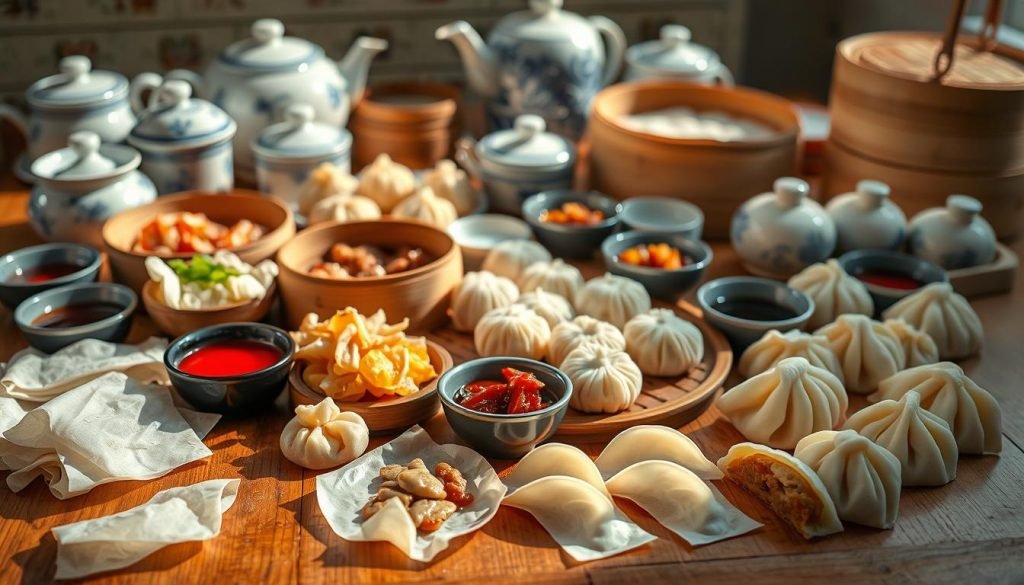
A simple Pork Dim Sum recipe with these items takes around 25 minutes. It makes about 24 dumplings, enough for four people.
| Nutritional Information (Per 8 Dumplings) | Amount |
|---|---|
| Calories | 348 kcal |
| Carbohydrates | 29 g |
| Protein | 17 g |
| Fat | 18 g |
| Saturated Fat | 6 g |
| Cholesterol | 49 mg |
| Sodium | 1356 mg |
| Potassium | 316 mg |
| Fiber | 1 g |
| Sugar | 2 g |
| Vitamin A | 313 IU |
| Vitamin C | 18 mg |
| Calcium | 41 mg |
| Iron | 3 mg |
Substitutions for Hard-to-Find Items
Sometimes, it’s hard to find certain dim sum ingredients. But substitutions can work well. They let you enjoy Asian cuisine without losing much authenticity. Here are some useful swaps:
- Baking Soda: Can replace tapioca starch for the right wrapper texture, though it looks a bit different.
- Gelatin: Works well as a binder in dumplings, like some starches do.
- Dry Sherry or Mirin: Good options instead of Shaoxing wine for marinating and seasoning.
Knowing these ingredients and how to swap them will help you make real Chinese dumplings and dim sum dishes at home.
Step-by-Step Guide to Making Dim Sum at Home
Start making homemade dim sum with our guide. We will show you how to make amazing dumpling wrappers and fillings. You will learn how to wrap them and steam them perfectly. Whether it’s Har Gao or Siu Mai, our tips will make your dim sum feast a hit.
Preparing the Dough and Wrappers
To begin, you need to make the dough. Here’s what you’ll need:
- 1 cup of wheat starch
- 1/2 cup of cornstarch (or tapioca starch)
- 1 1/4 cups boiling water (plus 1-2 teaspoons in dryer climates)
- 3 teaspoons of lard (or oil)
Using a kitchen scale helps with accuracy. Mix the starches, then add boiling water and mix. Knead until it’s smooth. The dough’s texture is very important for tasty dumplings.
Filling Ideas and Preparation
Now, let’s talk about fillings. For the popular Har Gao, you’ll need:
- 1/2 pound of raw shrimp
- 1 teaspoon of oyster sauce
- 1 tablespoon of vegetable oil
- 1/4 teaspoon of white pepper
- 1 teaspoon of sesame oil
- 1/4 teaspoon of salt
- 1 teaspoon of sugar
- 1/2 teaspoon of minced ginger
- 1/4 cup of finely chopped bamboo shoots
Mix everything together until it’s pasty. You can keep this mix in the fridge for days to enhance its taste.
Steaming Techniques for Perfect Dumplings
Steaming is key for these dumplings. Use a 12-inch bamboo steamer for the best results. Fresh dumplings need 10 to 12 minutes to steam. If they’re frozen, steam them for 12 to 14 minutes.
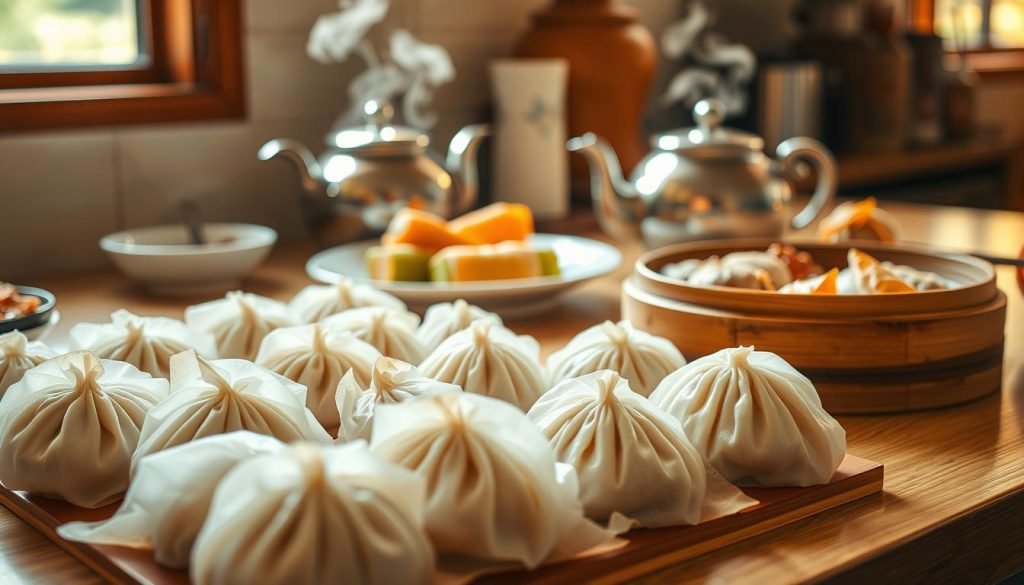
For Har Gao, steam for 6 minutes on high heat. Make each dumpling weigh about 22 grams. This recipe makes 18 dumplings to feed 6 people, with 3 dumplings each. Here’s what each serving has:
| Nutrient | Amount | Daily Value |
|---|---|---|
| Calories | 213 kcal | – |
| Carbohydrates | 30 g | 10% |
| Protein | 8 g | 16% |
| Fat | 6 g | 9% |
| Saturated Fat | 3 g | 15% |
| Cholesterol | 98 mg | 33% |
| Sodium | 424 mg | 18% |
| Potassium | 30 mg | 1% |
| Fiber | 1 g | 4% |
| Sugar | 1 g | 1% |
| Vitamin C | 1.6 mg | 2% |
| Calcium | 55 mg | 6% |
| Iron | 1 mg | 6% |
With these steps, you’re ready to make awesome dim sum at home. Remember, practice makes perfect. So, keep trying and enjoy making your Chinese dishes!
Tips for Hosting a Dim Sum Brunch
Make your home the perfect spot for dim sum with a pretty table and tasty dishes. Hosting dim sum lets you mix old tastes with new style. This makes brunch fun for everyone. Here’s how to be a great dim sum host and make your brunches better.
Setting the Table for Dim Sum
Create a warm atmosphere like in traditional dim sum places. Use big bamboo baskets with banana or bamboo leaves for showing your dishes. Pick melamine plates with Asian designs for beauty and toughness. Small plates are best. They let guests try many kinds of dim sum, like har gow, siu mai, and shrimp dumplings. Always have tea. A good dim sum meal needs lots of Chinese tea.
Pairing Dim Sum with Drinks
Choosing the right drinks can take your brunch from good to great. Go for traditional teas, like jasmine or chrysanthemum, to cut through the richness. If you like wine, try Sauvignon Blanc or Pinot Noir from Russian River Valley. Rice wine also goes well with dim sum, giving a real Chinese dining feel. These drinks make the meal better for everyone.
Etiquette and Serving Suggestions
Knowing how to serve dim sum makes brunch better. Serve it family-style so everyone can try what they like. When offering soup dumplings, or xiao long bao, make sure they’re cooked right. Serve dumplings right away to keep them fresh. Have vegan choices like shiitake mushroom and daikon dishes for different diets. Try a potluck. Everyone brings a dish, making things easier and more fun.
Follow these tips on serving, setting the table, and choosing drinks to host a memorable dim sum brunch. As more people enjoy dim sum at home, your place can be a favorite for these tasty events.